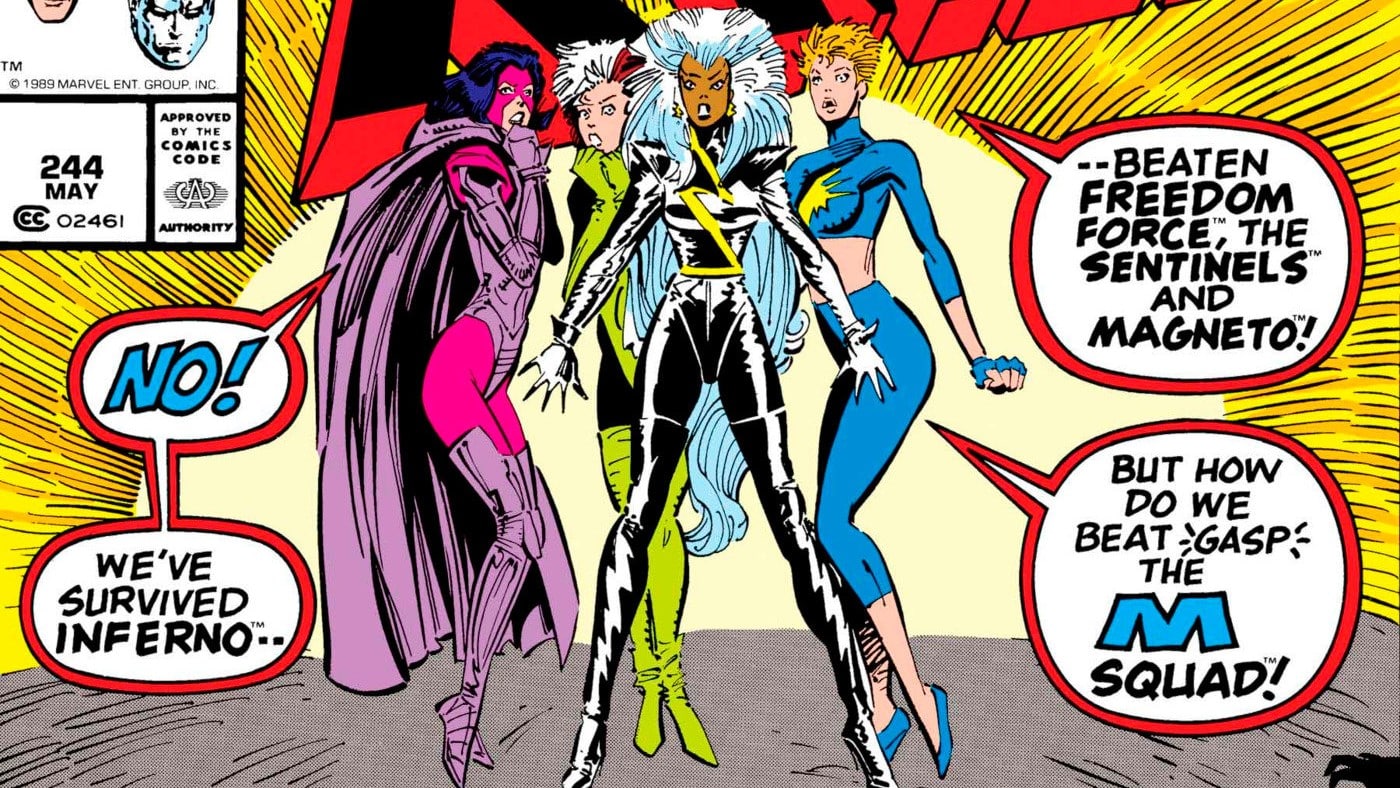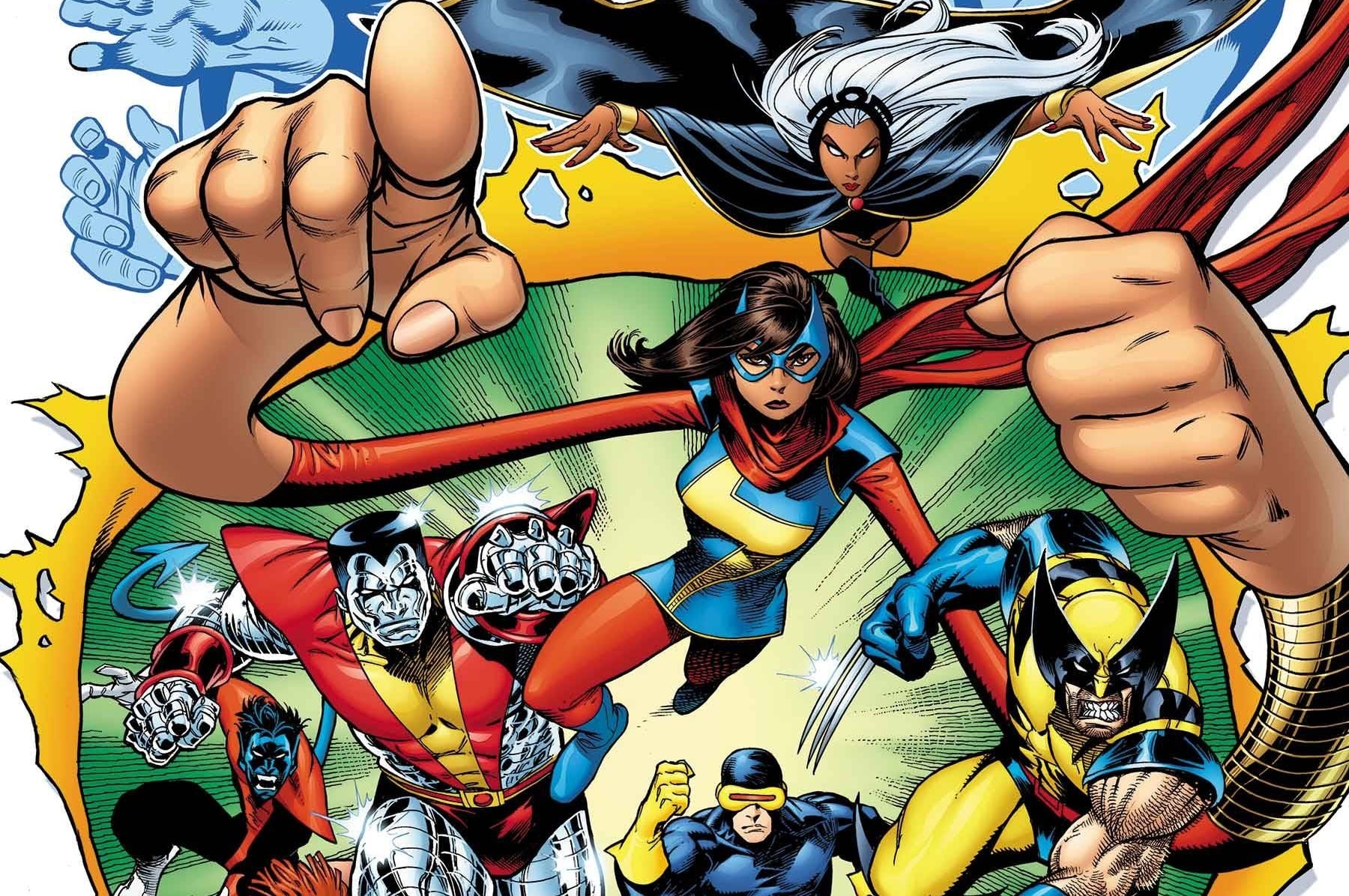Editor’s note: Marvel has again graced us with another facsimile edition of a classic X-Men comic, so enjoy this retro look at Jubilee’s first appearance.
“Inferno” is over and it’s time for the X-Men — or their female members, at least — to cut loose with a trip to the mall. But prejudice lurks everywhere, even and especially in the hearts of mall cops and mutant hunters, who have set their sights on an explosive mallrat named Jubilee in Uncanny X-Men #244, written by Chris Claremont, drawn by Marc Silvestri, inked by Dan Green, colored by Glynis Oliver and lettered by Tom Orzechowski.
Nowadays, Jubilee is known as a stalwart member of the X-Men. Currently part of the main cast of Gail Simone’s flagship Uncanny X-Men, she’s been Wolverine’s Robin-hued sidekick, an animated POV character, a core member of Generation X, mother of (a) dragon and, for a surprisingly long time, a vampire. But when Jubilee first appears in Uncanny X-Men #244, she is none of those things. In her first appearance, Jubilee is more like Slimer from Ghostbusters than one of the X-Men (or X-women).

Uncanny #244 is the first issue published after the conclusion of the multipart “Inferno” crossover, a story that paid off a series of plotlines running, in some cases, for years. Instead of providing a more traditional epilogue, a quiet downtime issue to reflect on the changes wrought on the characters by the story (the kind of thing Jubilee herself would later star in) or which tied up any narrative loose ends, writer Chris Claremont and penciler Marc Silvestri opt instead for an epilogue that serves as a sort of tonal palette cleanser. After all of the heat-infused demonic sturm und drang of “Inferno,” Uncanny X-Men #244’s “Ladies’ Night” sends the female members of the X-Men — Storm, Rogue, Psylocke and Dazzler — to a Hollywood mall for little more than an evening of shopping, makeovers and bonding (the literal X-Men will get their own night out in the subsequent issue, Uncanny X-Men #245‘s Rob Liefeld-drawn parody of DC’s “Invasion!” storyline).
Before the X-women arrive (this coming during the X-Men’s Outback era, when the team was operating out of a town in the Australian Outback, they are delivered via the Indigenous Australian Gateway’s teleportation powers), readers are introduced to Jubilee, a spunky mutant mallrat with the ability to create, in layman’s terms, fireworks, and in Claremontian terms, “articulate, quasi-animate transitory plasmoids.” (For younger readers, a “mallrat” was an individual, usually a teenager, who would hang out at a mall with no clear purpose like shopping or working, and a “mall” was what that Spirit Halloween in your town used to be before it was a Spirit Halloween.) In the opening pages of the issue, we see Jubilee using her powers to entertain a crowd, much to the consternation of the local gung-ho mall cops who (“heroically”) resist the urge to shoot her but do scare her into hiding. No one thinks Jubilee will be gone for long though, so as one cop does that “jump up and down so hard it makes puffs of dust appear” routine out of fear and hatred toward some combination of mutants and mallrats, another suggests they call in some professional help: M-Squad.

Debuting four issues earlier in Uncanny X-Men #240, during the early phases of “Inferno,” M-Squad is a loose parody of the Ghostbusters. With names taken from science fiction writers with whom Claremont had worked on the Wild Cards anthology series (including one George R.R. Martin), they are scientists with advanced backpack-based equipment who, after getting caught up in the events of “Inferno,” decide to turn to the private sector (like the Ghostbusters before them) and hunt mutants. They are, ultimately, quite terrible at their job. In part, this is because their “mutant busting” equipment has been transformed by the events of “Inferno” into the kind of horrifically comic possessed inanimate objects that formed the backdrop of “Inferno,” in which the participating heroes battled demonic mailboxes and possessed vacuum cleaners while the X-Men and friends fought the main players. It’s also because, like the Ghostbusters, their actual “busting” serves another purpose.
In Ghostbusters, the busting is a delivery system for gags, the sardonic wit of Pete Venkman or the boyish enthusiasm of Ray Stantz. In Uncanny #244, it’s to force Jubilee and the X-women together in a story that transitions the series back to something approximating normal by hanging onto a touch of “Inferno’s” absurdism while stripping out the more Grand Guignol elements of that story. So it is that M-Squad’s cat-and-mouse game with Jubilee ultimately draws the attention of the X-women, fresh from makeovers as they push Storm to dance with a shirtless, feather-haired Chippendale’s stand-in. That they settle the conflagration quickly is, of course, the point: M-Squad is meant to be a gag, a means to an end, not an actual threat.

They ultimately serve the purpose of bringing Jubilee and the X-women together. In the closing pages of the issue, Claremont reveals that Jubilee is meant to be more than a one-off plot device, more than the Slimer to the M-Squad’s Ghostbusters. Watching the glamorous women who saved her disappear into a portal, Jubilee follows behind them, plunging into the unknown, giving up her mallrat existence for whatever lies on the other side. To underscore that this is the beginning, and not the end, of her story, Claremont even anchors her to the narrative with a couple of his patented mysteries: The closing panels note that Psylocke is unable to read Jubilee’s mind, and it is heavily implied that Gateway consciously left his portal open long enough for Jubilee to go through it, somehow knowing she was deciding what to do and needed an extra moment. With Uncanny #244 having cleansed the series’ palate of the darker, more gothic elements of “Inferno,” the book would soon move past its absurdism as well, returning to more traditional comic book stories (in tone, if not structure). Jubilee would undergo that transition in microcosm as well, changing from the spunky mallrat Slimer bedeviling the inept mutants hunters into a core member of the X-Men.
Austin Gorton also reviews older issues of X-Men at the Real Gentlemen of Leisure website, co-hosts the A Very Special episode podcast, and likes Star Wars. He lives outside Minneapolis, where sometimes, it is not cold. Follow him @austingorton.bsky.social.






